Samgyetang (삼계탕) or Korean ginseng chicken soup is a popular soup enjoyed in Korea on the hottest days of the summer and whenever someone is under the weather. Each serving consists of a Cornish hen stuffed with glutinous rice, ginseng root, jujube, and garlic. It's super nutritious, light, and perfect with some cubed radish kimchi or regular napa cabbage kimchi.
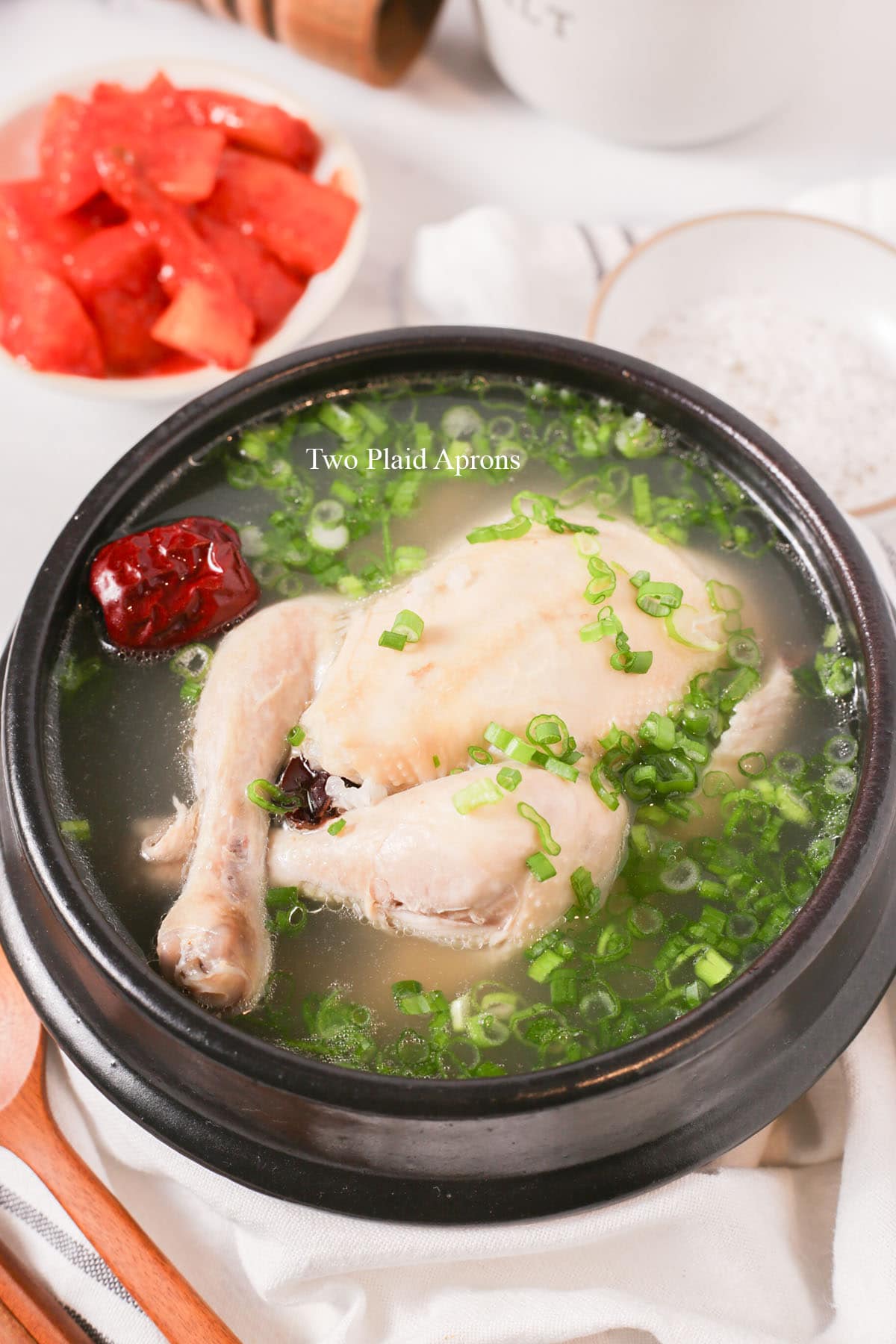
If you’ve made this recipe or any recipes from our blog, please tag us on Instagram using #twoplaidaprons! You can also tag us in your Instagram stories using @two_plaid_aprons. We would love to see your creations! It absolutely makes our day! 🥰
Jump to:
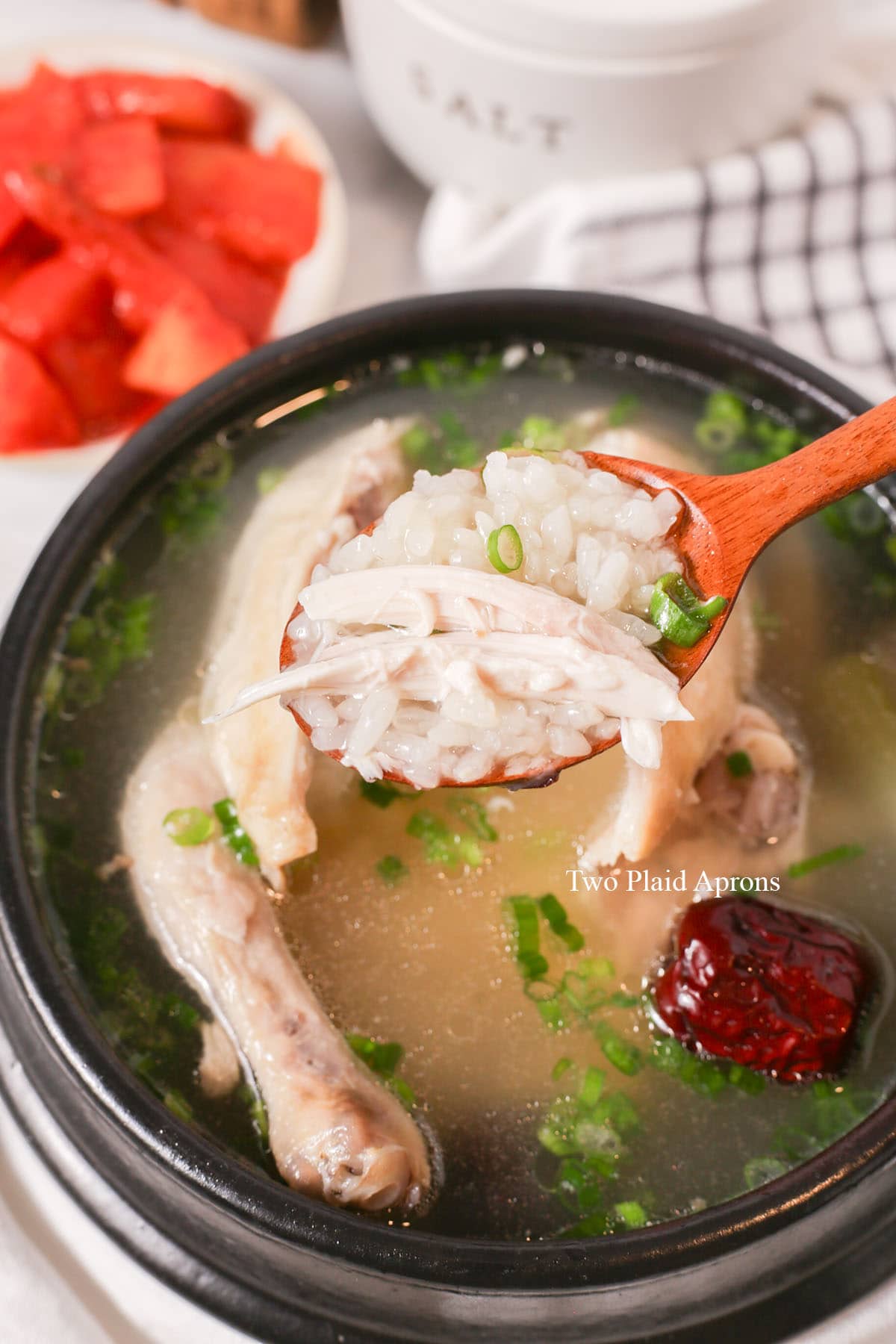
What is samgyetang?
Samgyetang (삼계탕), or ginseng chicken soup in English, is a hot, nutritious soup consisting of a small chicken (usually a Cornish hen) stuffed with glutinous rice, ginseng root, jujube, and garlic. The chicken is slowly simmered until tendered, topped with lots of green onions, seasoned to taste at the table with salt and pepper, and often served with kkakdugi, or cubed radish kimchi.
This Korean ginseng chicken soup is often time served on the 3 hottest days in the summer to give you more energy, help you sweat out toxins in your body, and help balance your body's internal "heat". This is known as "fighting fire with fire" in many Asian cultures.
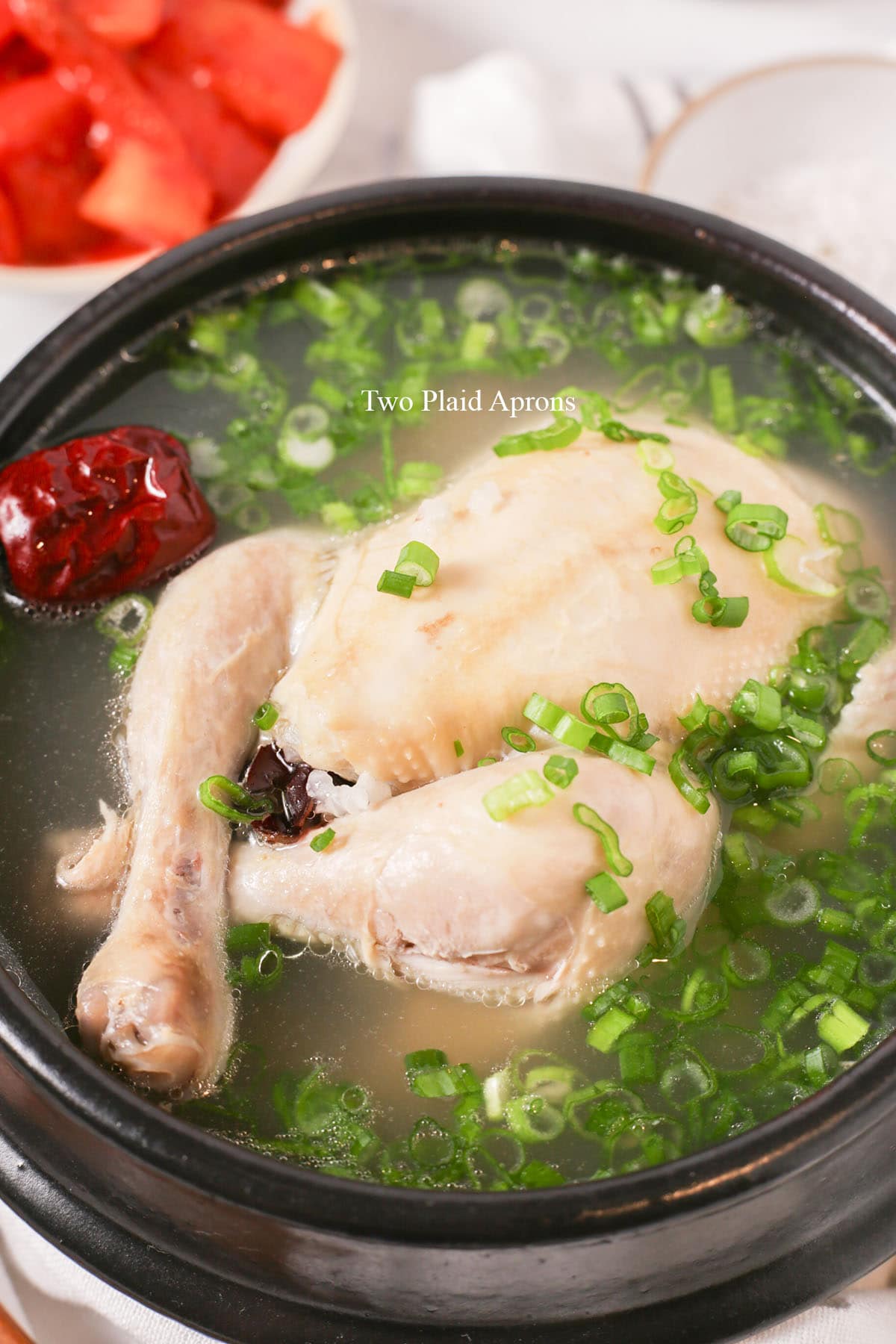
Ingredient notes
Please scroll down to the recipe card for the ingredient quantities!
- Cornish hen - You can usually find Cornish hen at your local grocery stores and at the Asian market. They are typically located in the freezer aisles with other poultry or frozen meat.
- Glutinous rice - Also known as sweet rice or sticky rice. Unlike what its name suggests, glutinous rice is actually gluten-free. "Glutinous" refers to the sticky, chewy texture it develops after cooking, as seen in mango sticky rice and zongzi (Chinese rice dumplings).
- You'll commonly find 2 versions — long and short grain. Although either is okay, the short grain glutinous rice is the preferred choice.
- Garlic - Whole garlics are stuffed into the hens and added to the soup to flavor the samgyetang.
- Ginseng root - This is a must for making samgyetang, as the name of the dish is ginseng chicken soup, and it's super nutritious. You can find fresh ginseng roots at Asian markets like HMart, but dry ginseng roots are much more accessible and are available at most Asian markets.

- Dry jujube - These are dry red dates, and they're a popular addition to soups and for making teas in Asian cuisine. They add extra nutrition and a mild sweetness to the soup.
- Green onion - The white parts of the green onion is added to the soup during the cooking process to add flavor, and the green parts are added to the soup at the end for garnish, color, and flavor. It is common to add A LOT of green onions.
- Water - For making the soup, although if you want to make your ginseng chicken soup extra nutritious, you can use homemade chicken stock or broth.
- Salt and black pepper - For seasoning.
- Optional herbs - You can also use other medicinal herbs like milk vetch roots (Astragalus membranaceous) and liquorices in a stock pouch and add it to your samgyetang for extra nutrition.
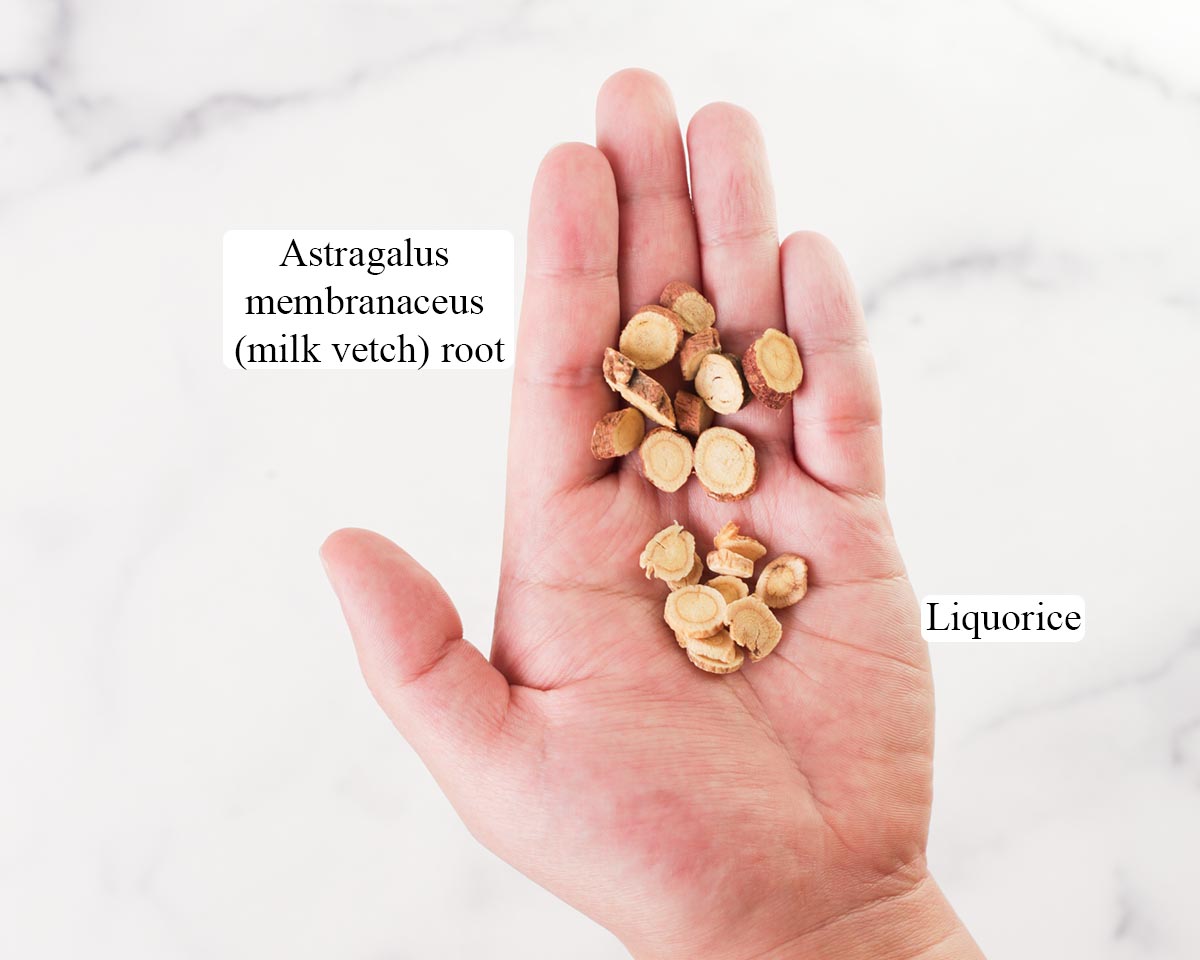

Ginseng substitute
Unfortunately, as the name of this dish suggests, there's not really a proper substitute for ginseng in samgyetang. It's a must in the soup to give the nutrition and "detoxifying" effect that ginseng is known for.
However, ginseng roots are sold both fresh and dry. The fresh roots can be a bit harder to find, but dry ginseng roots are much more accessible and usually available at most Asian markets. You may need to ask the market staff to get the ginseng from behind their counter as they can be kind of pricey.
If you cannot find ginseng, you can definitely still make this soup and it'll still tastes amazing! However, it won't be samgyetang but more like a baeksuk, which is simply a Korean style chicken soup.
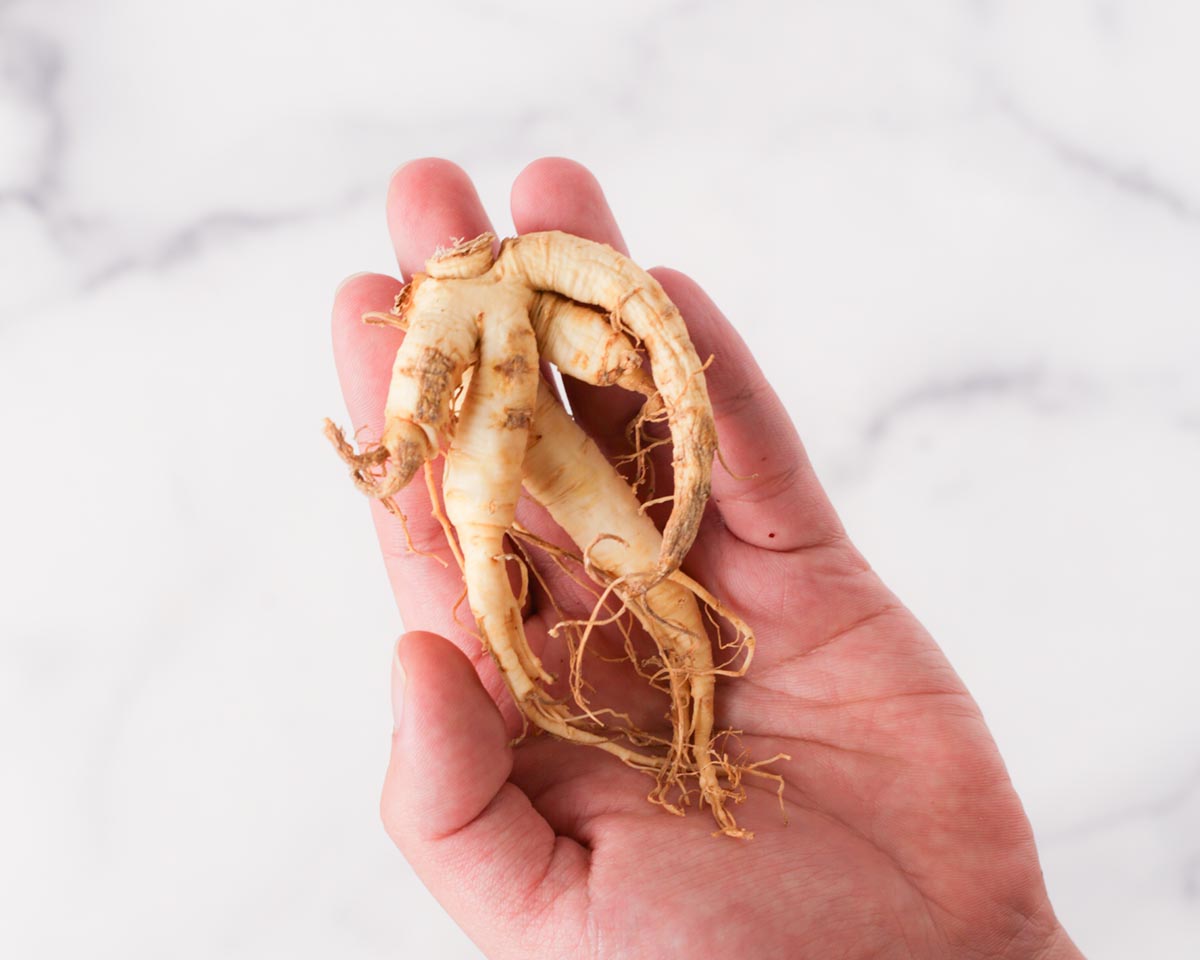
Samgyetang kit
Purchasing all these dry ingredients to make samgyetang can be quite costly and a waste, especially if you need or use these ingredients often for other recipes. But if you have a good Asian market near you, you may just be in luck!
Many Asian markets sell these samgyetang kits that provides the glutinous rice, dry jujube, a mix of dry herbs, and sometimes dry gingko nuts and/or chestnuts. These kits usually cost around 8 to 15 dollars, which is definitely worth it if you don't make samgyetang often and it's quite convenient to have the most of the ingredients basically all measured for you. However, do note that some of these kits do not come with ginseng. So you may still need to purchase fresh or dry ginseng roots.
These kits below actually comes with some dry ginseng! We found these kits on Amazon: first kit (brand: Surasang) and second kit (brand: Choripdong)


How to make samgyetang
Please scroll down to the recipe card for the full recipe and instructions!
Prepare the ingredients:
1. Soak glutinous rice. Wash and rinse the glutinous rice a few times until the water runs mostly clear. Then cover the rice with water and allow it to soak for at least 30 minutes. Once done, drain well.

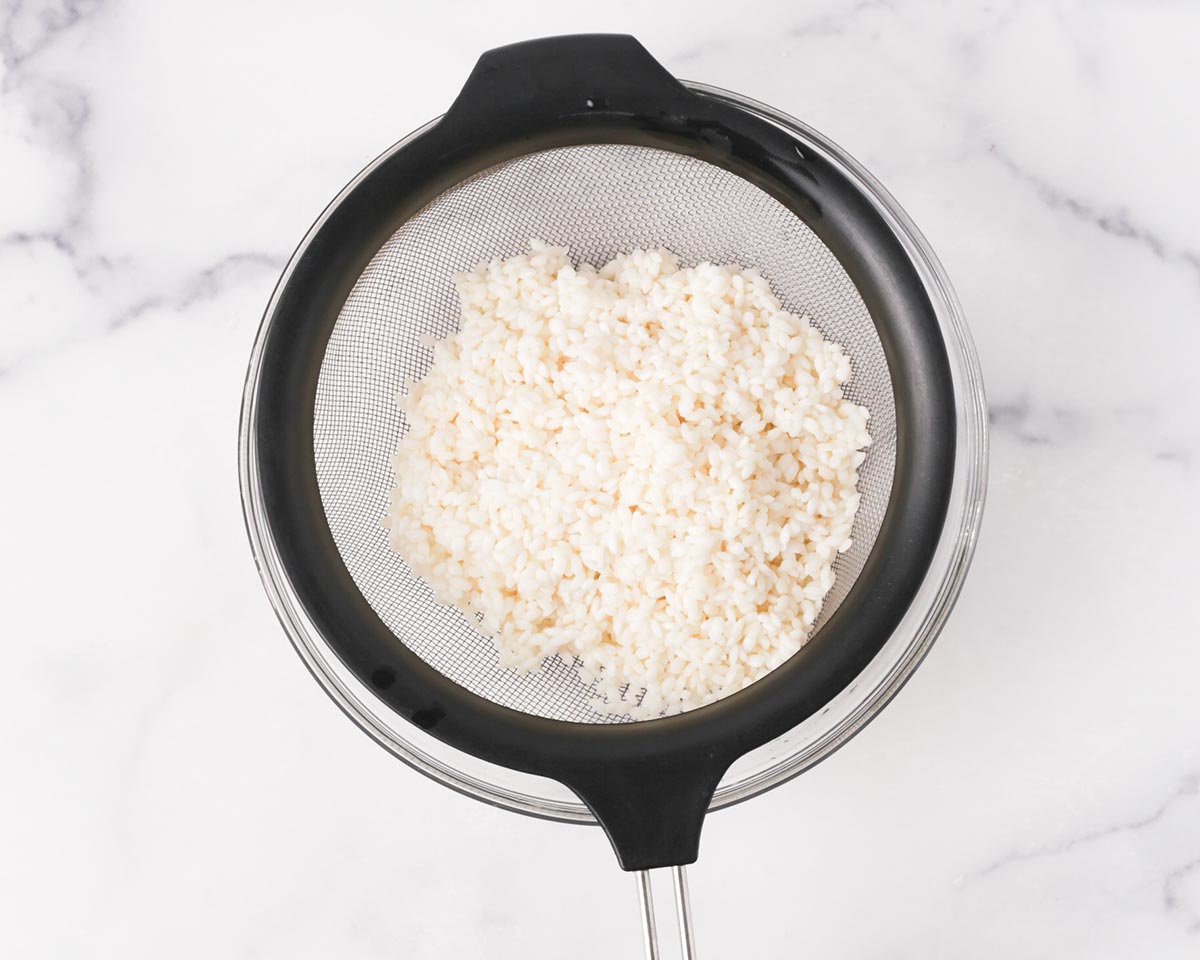
2. Clean the hens. Remove the giblets and rinse the hens to wash away any blood. Pat the outside and inside cavity dry with paper towels. Trim away the excess fat around the neck and butt. Also, cut off the wing tips and tail if you'd like.
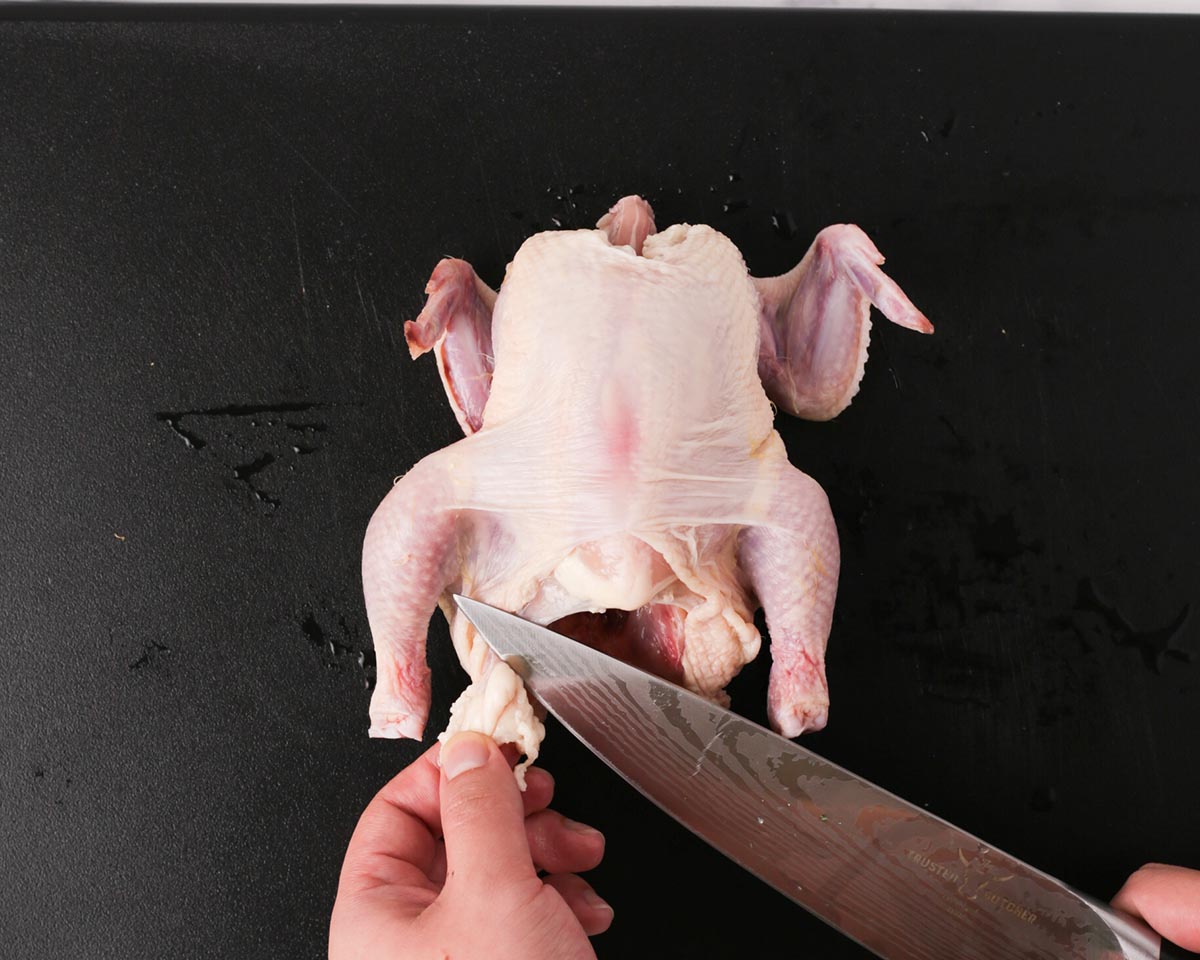
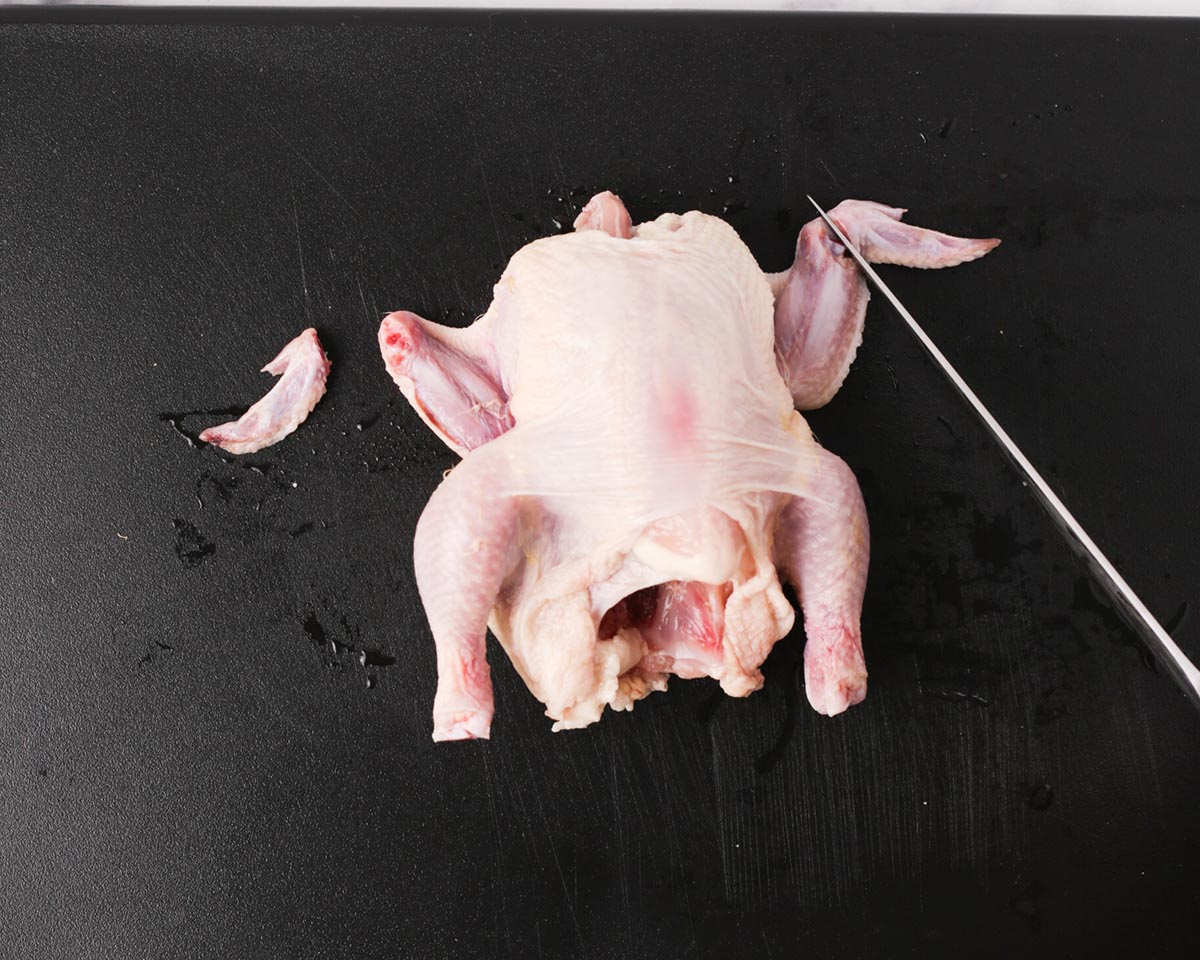
Stuff the hens:
3. Add the stuffing. In each hen, place some of the soaked glutinous rice, a ginseng root, a jujube, and a clove of garlic.

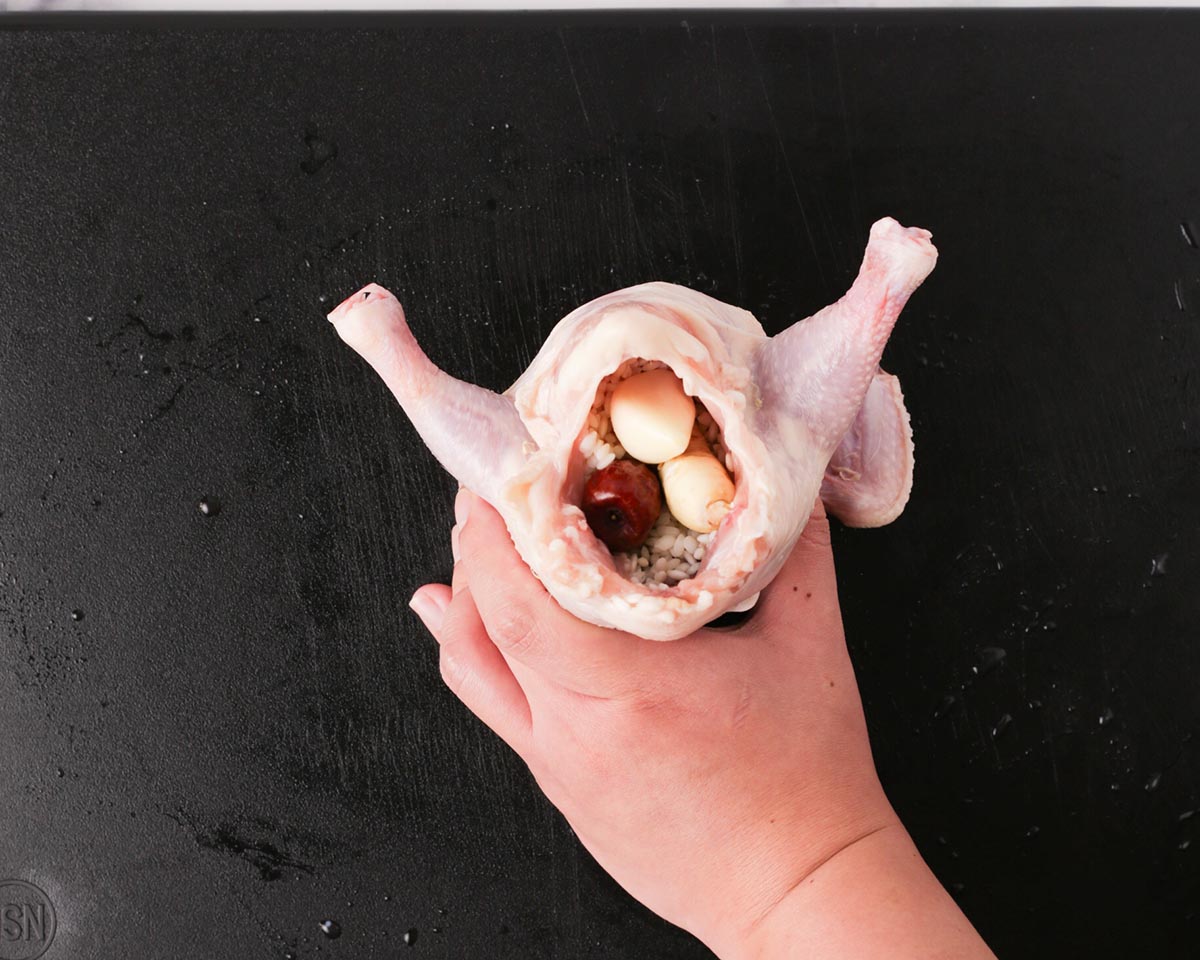
Add more rice to fill up the cavity as much as possible, about a ¼ cup of rice total. You can gently tap the hen to help compact the rice more.
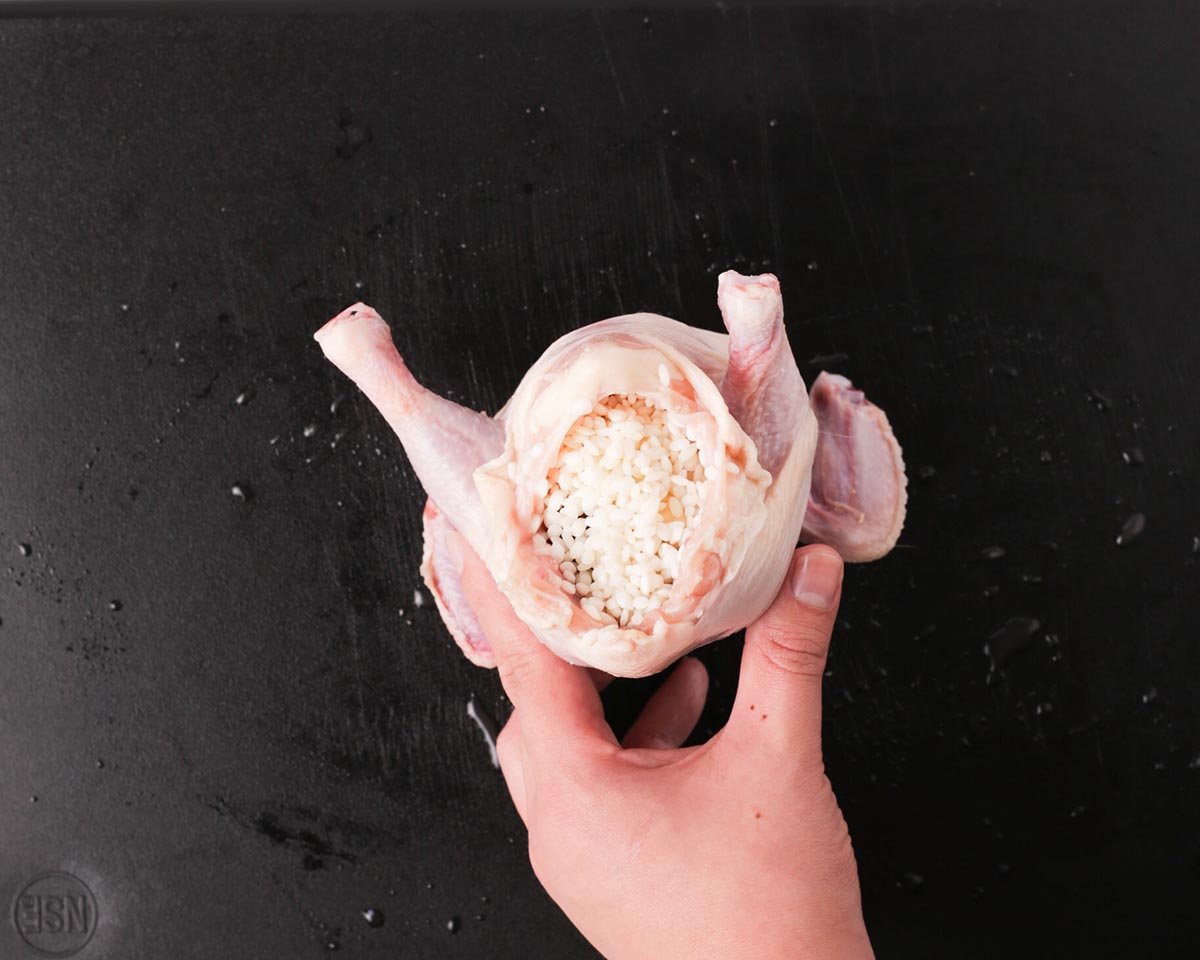
4. (Optional) Secure the stuffing. Make an incision in one leg of each hen. Try to make the incision as close to the bottom joint of the leg as possible and make sure to cut all the way through to the other side of the leg.
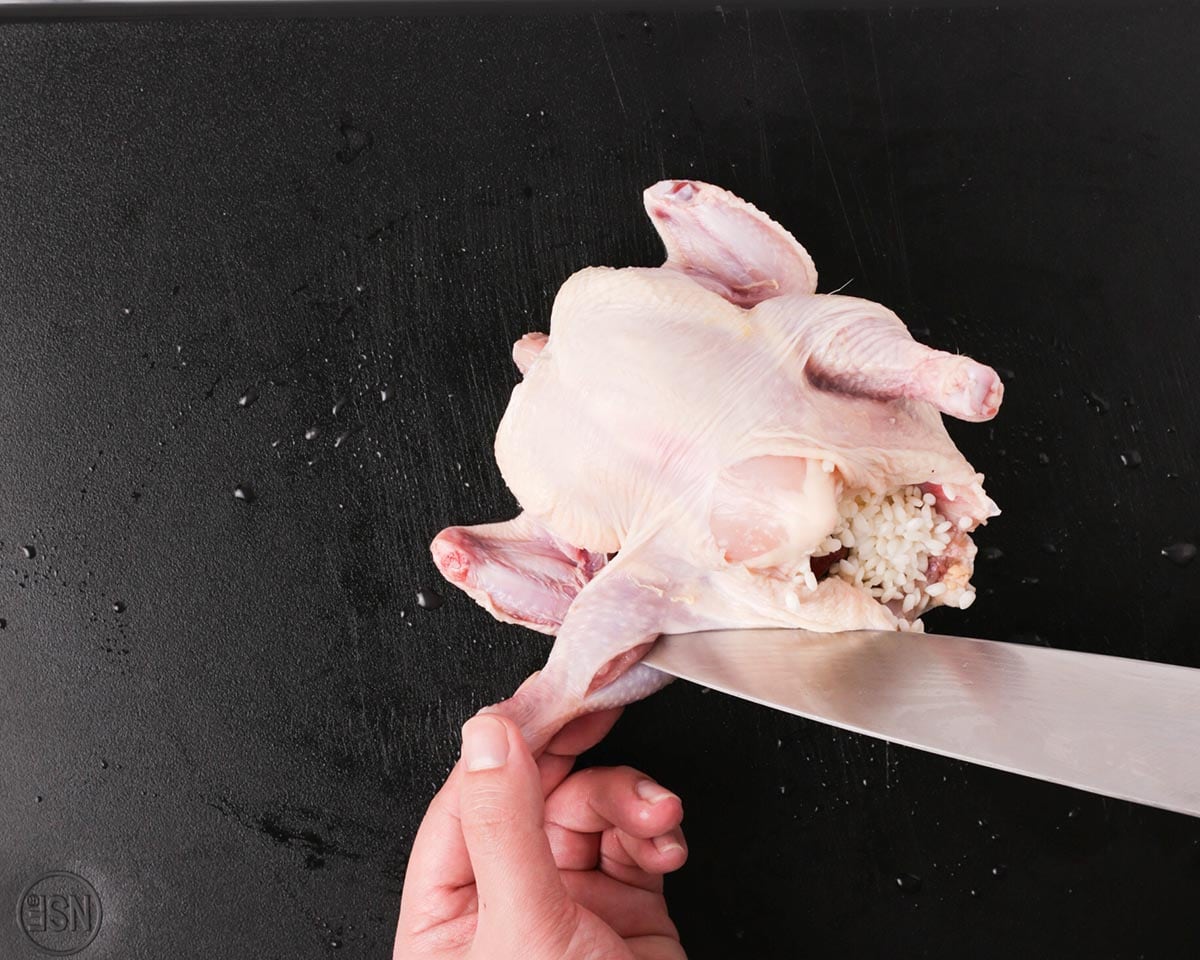
Then, insert the other leg through the cut. Make sure to push it through all the way to lock the leg in. This is so that the stuffing stays secure inside the hen while cooking.
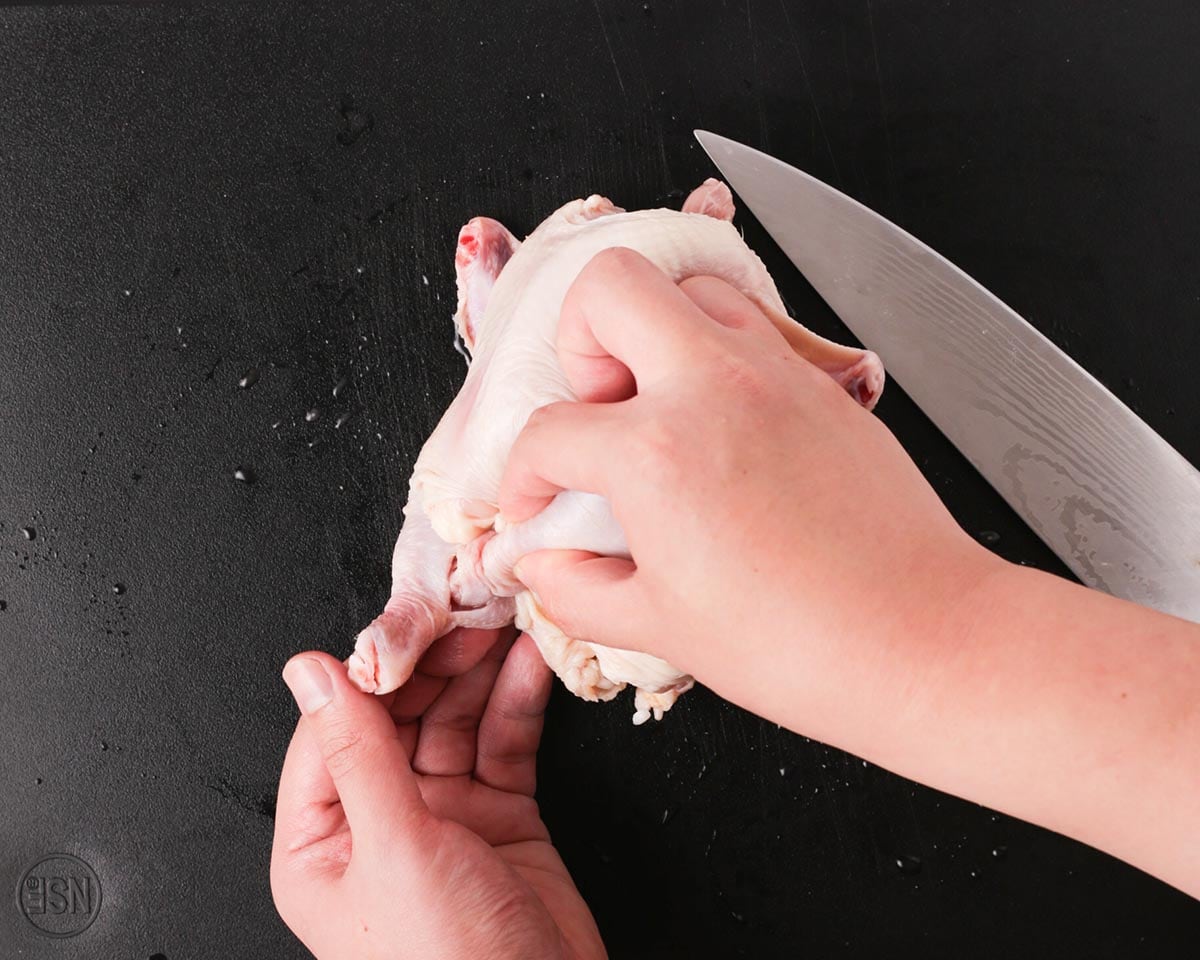
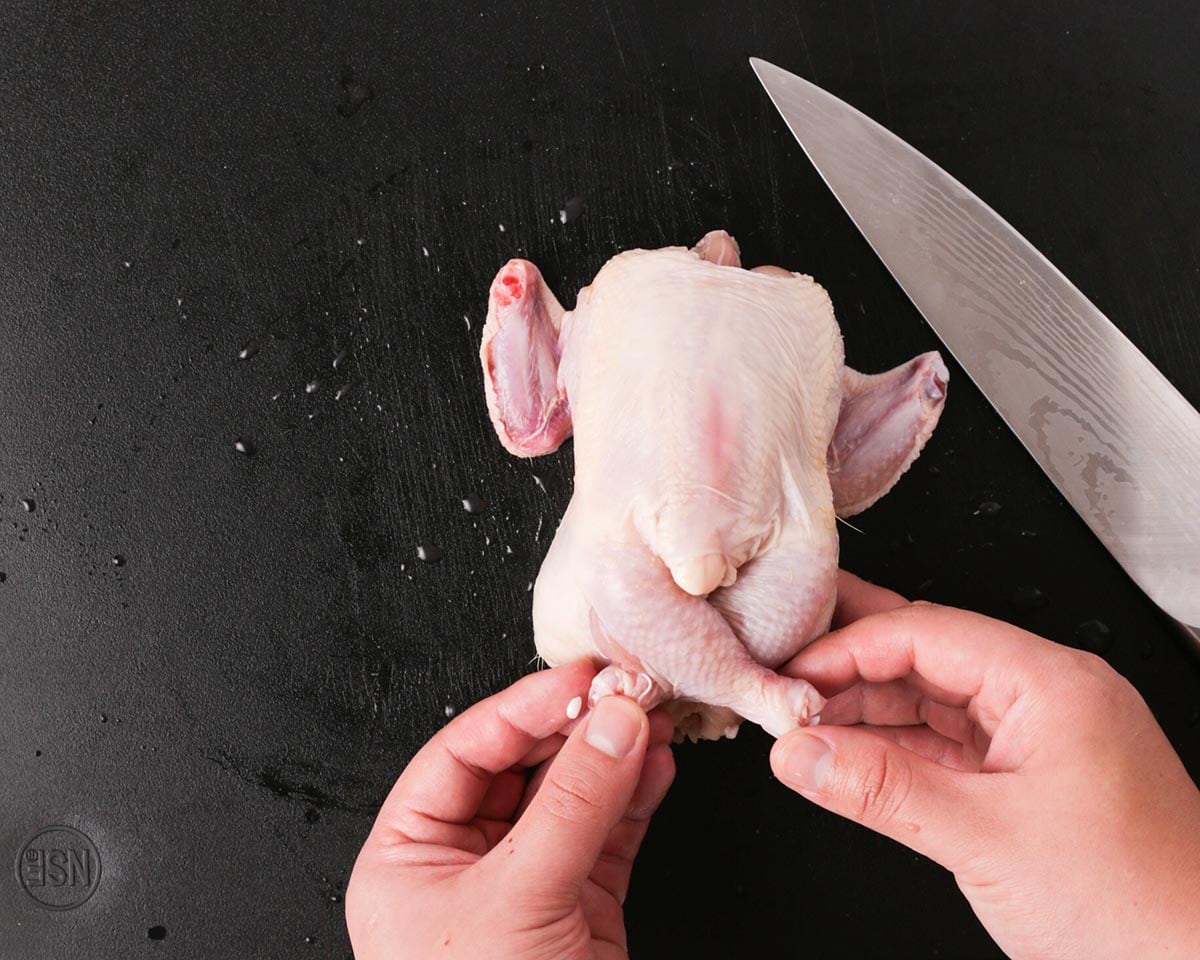
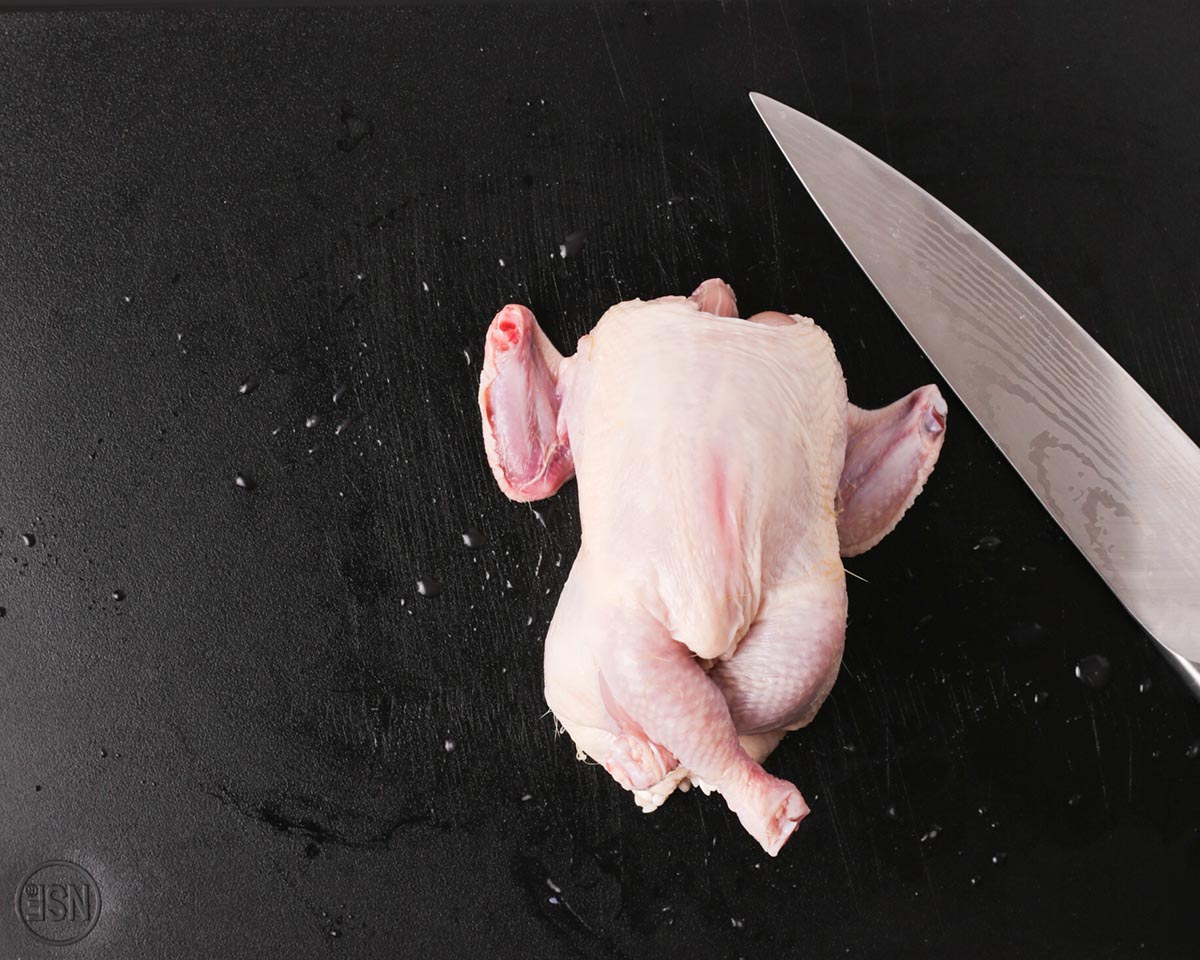
🌟 Alternative: If the method above is a little hard, you can try this alternative method using a toothpick. Pinch the extra skin around the bottom cavity and stick the toothpick through in a back and forth motion, like sewing. This will close up the cavity. Just make sure to remove the toothpick before serving.


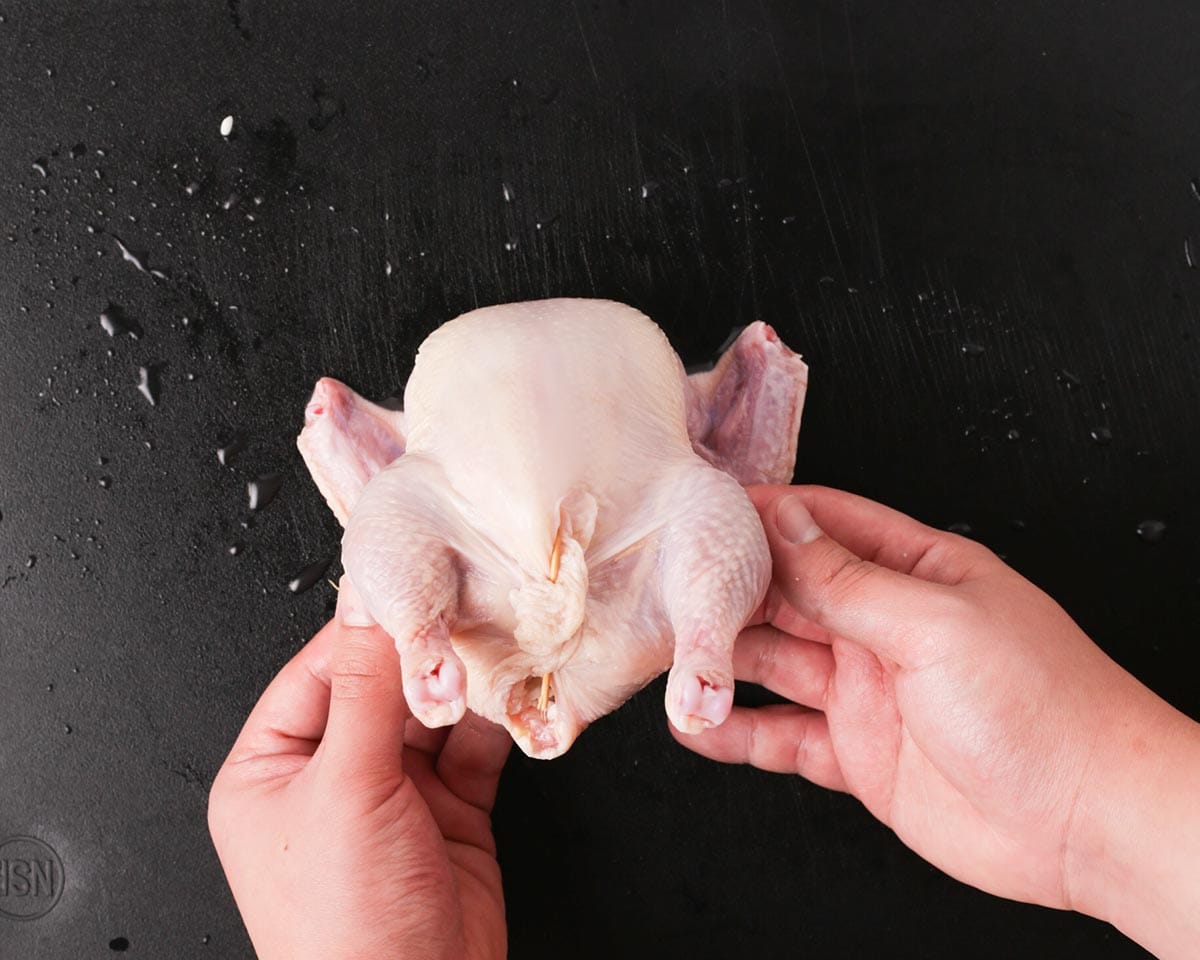
Stovetop method:
1. Place the stuffed hens into a large pot and add the water, any leftover ginseng, the leftover glutinous rice, the remaining garlic cloves, the whites of the green onions, and the optional herb pouch if desired.
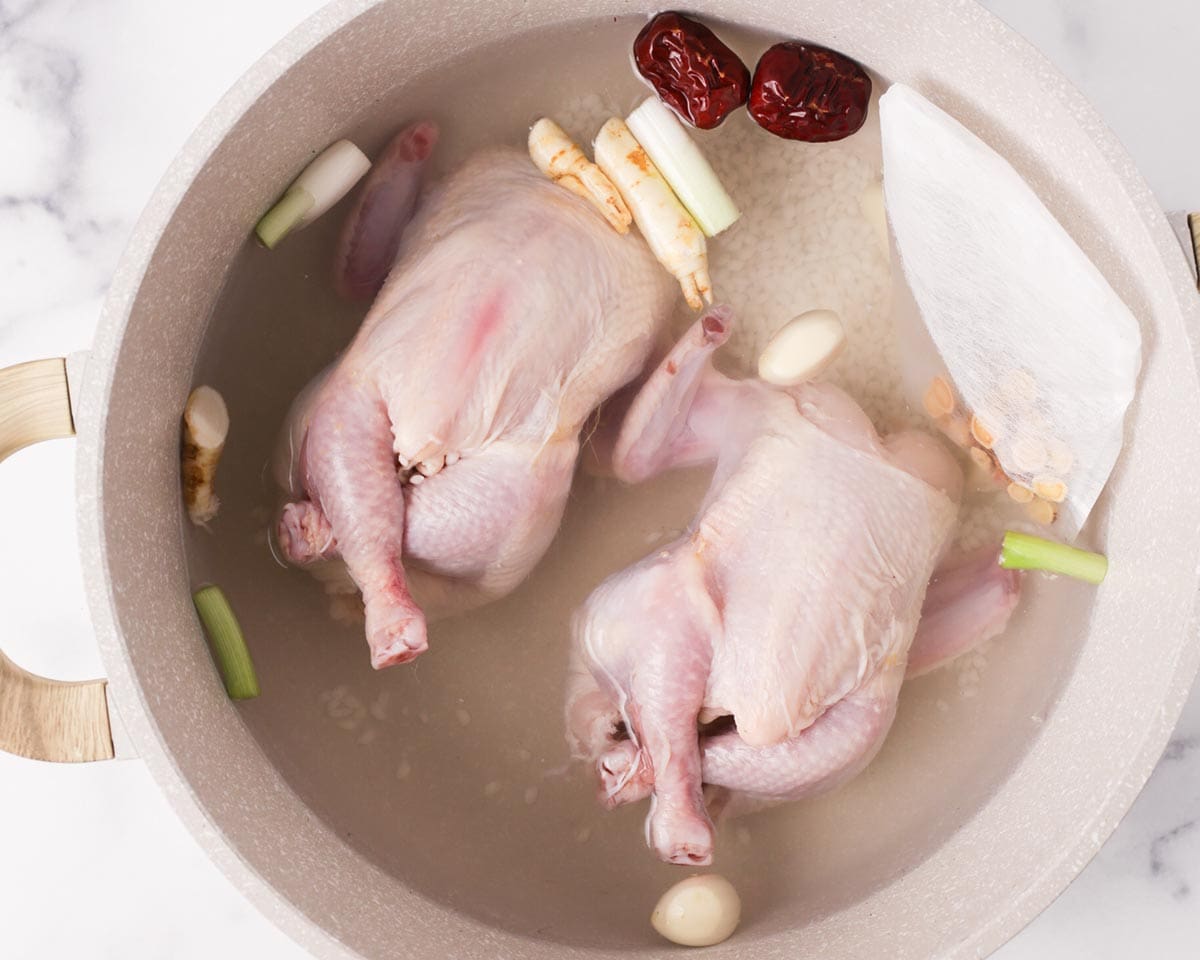
2. Cover the pot and bring to a boil. Once the soup is at a boil, reduce the heat and keep it at a gentle simmer. Skim the surface of the soup occasionally and discard the scum. Keep the soup covered and simmer for about 1 hour 30 minutes or until the hens are tender.

🌟 Pro tip: It is ideal to keep the hens submerged while cooking. So we highly recommend a tall pot rather than a wide pot. For two hens, we recommend a pot that can hold at least 6 quarts of liquid.

Rice cooker method:
*This method has only been tested with our current rice cooker (Cuckoo - CRP-JHR1009F), which has the "chicken soup" function. As we test more functions, we will update this cooking method to make it more adaptable for other models of rice cookers.*
1. Place the stuffed hens into the rice cooker pot and add the water, any leftover ginseng, the leftover glutinous rice, the remaining garlic cloves, the whites of the green onions, and the optional herb pouch if desired.

📝 Note: Our rice cooker has a 10 cup capacity which is perfect for making 1 recipe. If you have a smaller rice cooker, you'll need to reduce the water amount to the max line in the rice cooker pot instead.
2. Close the lid and lock according to the rice cooker. Select the "chicken soup" function. This actually makes the most perfectly tender chicken (but not fall-apart) and concentrated soup with minimal efforts.
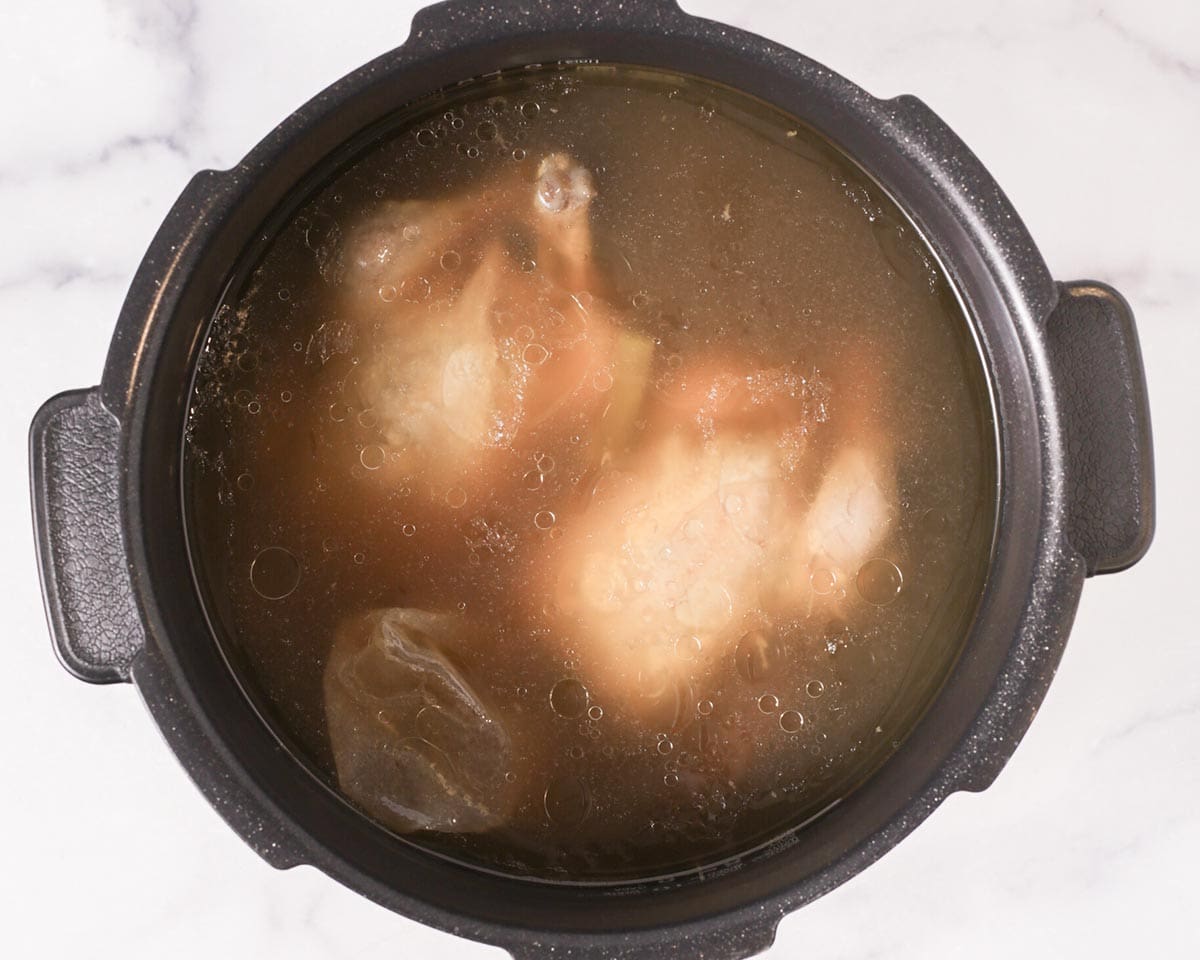
Instant Pot method:
1. Place the stuffed hens into the Instant Pot insert and add the water, any leftover ginseng, the leftover glutinous rice, the remaining garlic cloves, and the whites of the green onions.
2. Close and lock the Instant Pot and turn the venting valve to SEAL. Select pressure cook, high pressure, and 20 minutes.
3. Once it's done cooking, allow the Instant Pot to natural release for 5 minutes then quick release the rest of the pressure. If you prefer the hens more tender, allow it to natural release for 10 minutes before quick releasing.

How to serve and eat:
1. Once the hens are tender, the samgyetang is done. Place each hen into a ttukbaegi (also known as a Korean earthenware bowl), along with your desired amount of the soup. You can also just simply serve the dish in a regular bowl and skip the next step.
2. Bring the soup to a boil in the ttukbaegi and top with lots of sliced green onions. Serve immediately while the soup is boiling and season to taste with salt and pepper.
3. Debone the chicken and shred up the meat. Discard the bones. Also break up the rice and mix it into the soup. Season the soup to taste with salt and pepper. You can dip the shredded chicken in more salt and pepper on the side if you wish. You can also eat or discard the ginseng and jujube.
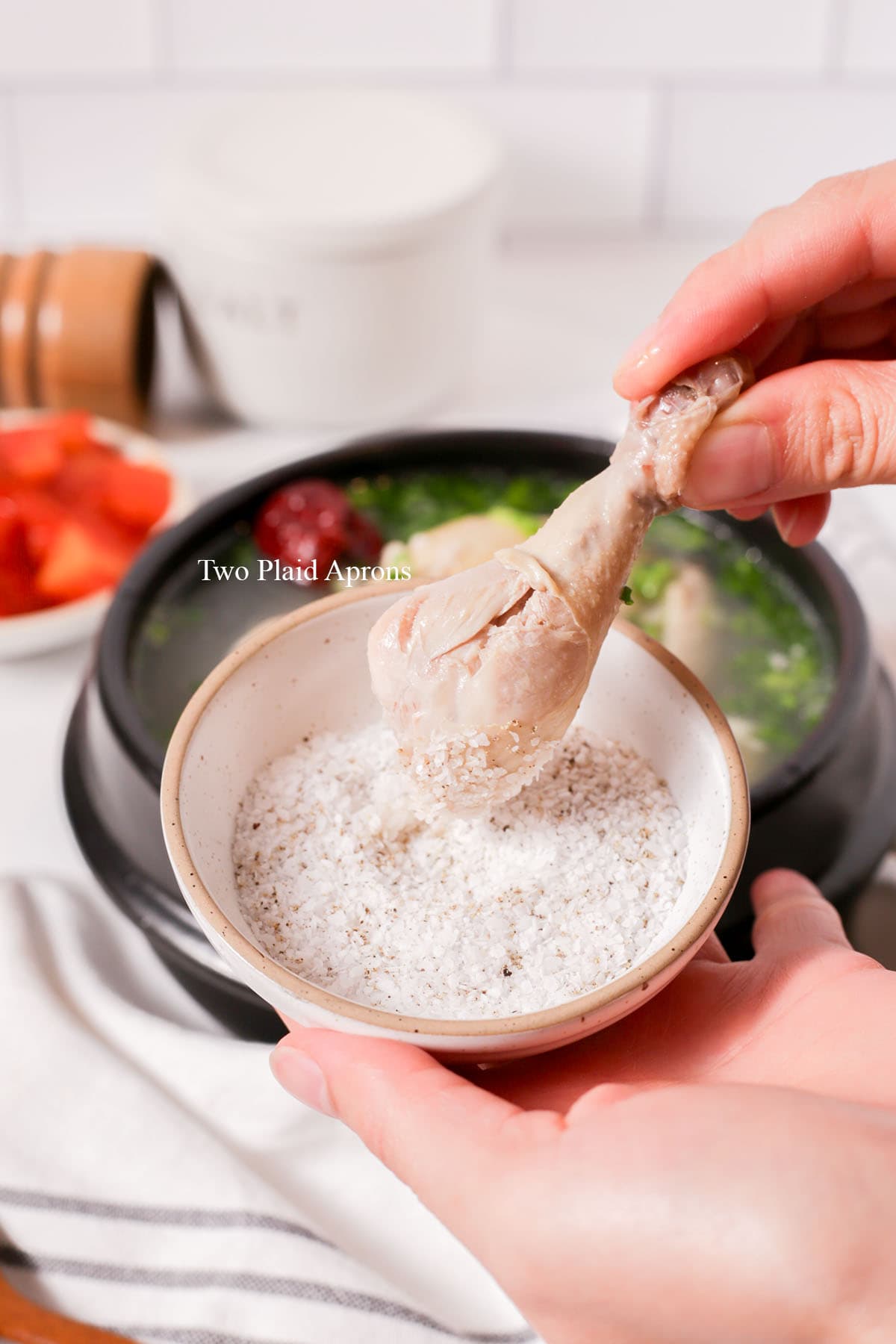
Recipe tips
- Don't skip soaking the glutinous rice. This is especially important if you're cooking on the stovetop and not using a pressure cooking appliance, like a rice cooker or Instant Pot. Soaking the rice helps to ensure the rice gets properly cooked and sticky.
- Seal the chicken's cavity if possible. Although you don't have to, we highly recommend sealing the cavity to prevent the stuffing from coming loose and out of the chicken while cooking. Check "How to make samgyetang" for instructions and photo references!
- Don't overcook the chicken. We absolutely want the chicken to be tender, however, not so overcooked that it disintegrates. The chicken should be tender but still hold itself together for a good presentation.
- Try to keep the chicken submerged while cooking. This ensures that the whole chicken is evenly cooked and all the flavor is infused with the chicken and the soup. If you're cooking on the stovetop and your pot is on the wider side and your chicken is exposed, you may want to turn the chicken occasionally while cook.
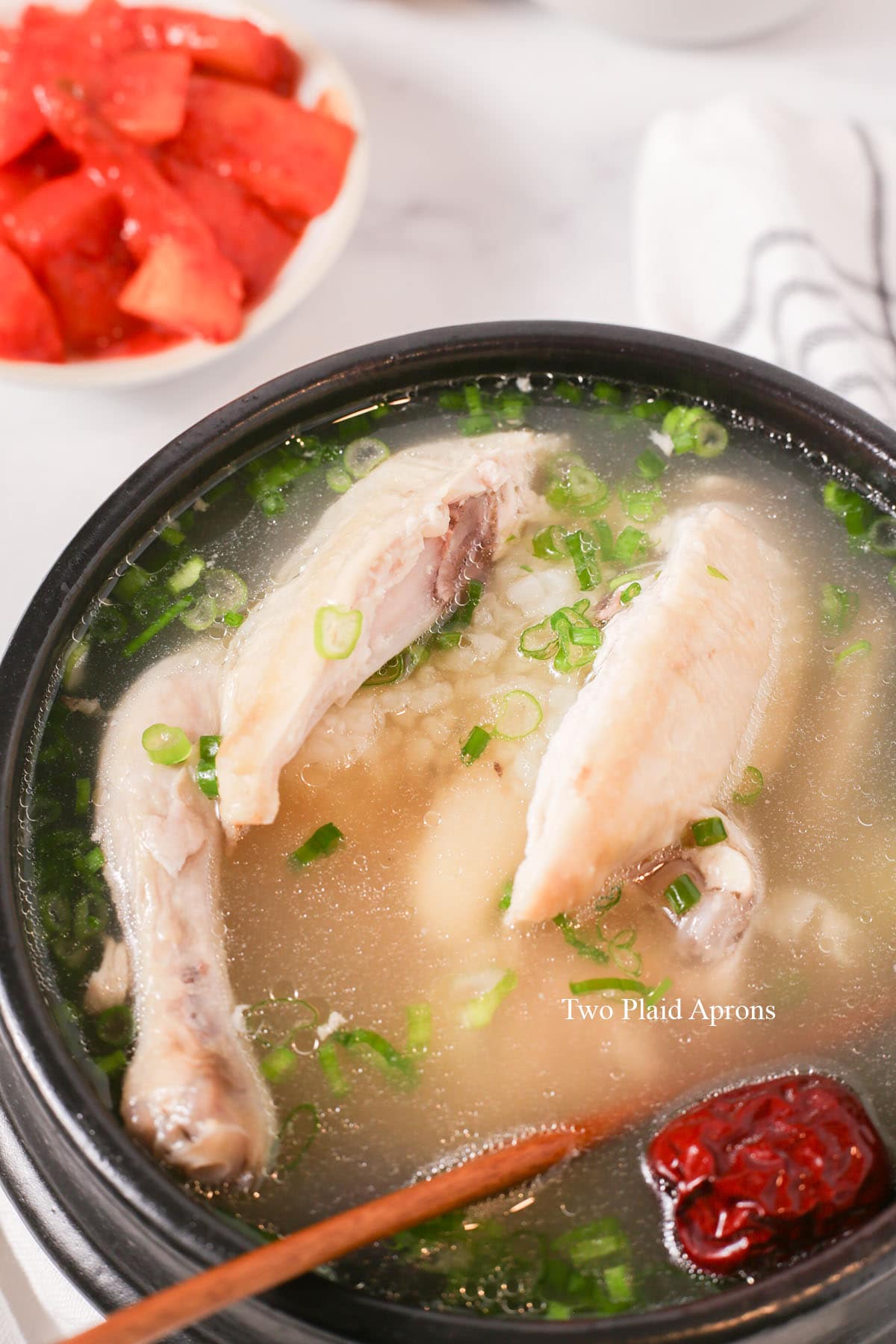
Storage
Leftover samgyetang is perfect for storing to enjoy later! Simply transfer the stuffed hen into an airtight soup container and top it with as much soup as possible.
This ginseng chicken soup will stay good in the fridge for up to 4 days and up to 3 months in the freezer. If freezing, make sure to leave about an inch of space between the soup and the lid to allow space for expansion.
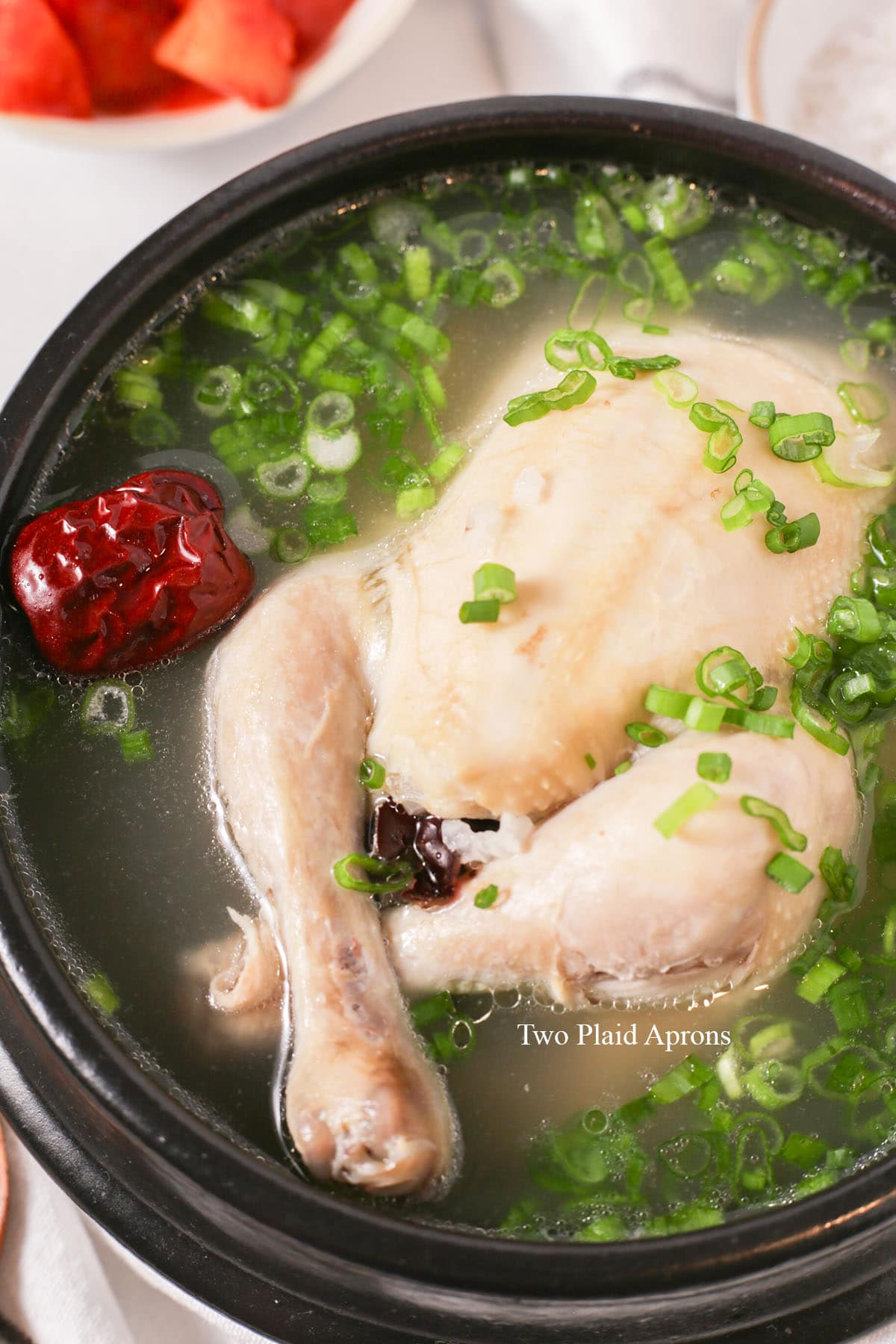
Reheating
Samgyetang can be easily reheated on the stovetop but can be reheated in the microwave as well. If frozen, make sure to move the soup to the fridge to let it thaw overnight or on the kitchen counter for a couple of hours.
Stovetop method: Transfer the samgyetang into a large saucepan (or pot, depending on how much you're heating up). Heat the soup over medium to medium high heat until the soup and the inside of the chicken is hot. Stir occasionally.
Microwave method: Place the soup into a microwave safe container and cover loosely. Microwave until both the soup and the inside of the chicken is hot.

FAQ
This is really up to your personally preference whether to eat or discard the ginseng root in samgyetang. Most people discard the ginseng since most of the flavor and nutrition is already infused into the soup, chicken, and the rice.
Samgyetang is served unseasoned and you get to season it to your preference at the table with salt and pepper. Seasonings aside, samgyetang tastes light and clean with a mild, slightly earthy, sweetness from the ginseng and jujube. Also, depending on how much glutinous rice you add to the soup, the soup can take on a thicker or thinner body. But either way, samgyetang has a simple, comforting flavor that tastes incredibly delicious!
📖 Recipe
Samgyetang (Korean Ginseng Chicken Soup)
Ingredients
For the ginseng chicken soup:
- 2 Cornish hen (about 1-2 pounds each)
- ¾ cup short grain glutinous rice *see notes
- 6 cloves garlic kept whole
- 2 pieces ginseng root cut into smaller size if needed *see notes
- 2 pieces dry jujube
- 2 stalks green onion cut the white parts into 1-2 inch pieces and thinly slice the green parts
- 8 cups water
- Salt and black pepper
Instructions
Prepare the ingredients:
- Soak glutinous rice:Wash and rinse the glutinous rice a few times until the water is mostly clear. Cover the rice with water and allow it to soak for about 30 minutes. After soaking, drain well.
- Clean Cornish hens:Remove the giblets and rinse the hens well. Then pat them dry with paper towels. Trim the excess fat off the hens (around the neck and butt area). Also, cut off the wing tips and the tail if you'd like.
Make the ginseng chicken soup:
- Stuff each of the hens with about ¼ cup of the soaked glutinous rice, a piece of ginseng, a jujube, and a clove of garlic.
- Optionally, make an incision into one leg of each hen, as close as possible to the joint area. Make sure to cut all the way through the leg. Stick the other leg of each of the hens through the cut. This helps to keep all the stuffings in while cooking.*Please refer to the post above for photo references!*
- Stovetop method:Place the stuffed hens into a large pot and add the water, any leftover ginseng, the leftover glutinous rice, the remaining garlic cloves, and the whites of the green onions. Cover the pot and bring to a boil. Once the soup is at a boil, reduce the heat and keep it at a gentle simmer. Skim the surface of the soup occasionally for scum. Keep the soup covered and simmer for about 1 hour 30 minutes.*For 2 hens, the pot should be big enough to hold at least 6 quarts of liquid. We recommend taller pots over wide pots when cooking only 2 hens. This way the water can cover the hens while cooking.*
- Rice cooker method:*We've only tested with our current rice cooker, which is the one recommended in our equipment list below (CRP-JHR1009F). As we test more functions, we will update this cooking method to make it more adaptable for other models of rice cookers.*Place the stuffed hens into the rice cooker pot and add the water, any leftover ginseng, the leftover glutinous rice, the remaining garlic cloves, and the whites of the green onions. Close the lid and lock according to your rice cooker. Select the "chicken soup" option.
- Instant Pot method:Place the stuffed hens into the Instant Pot insert and add the water, any leftover ginseng, the leftover glutinous rice, the remaining garlic cloves, and the whites of the green onions. Close and lock the Instant Pot and turn the venting valve to SEAL. Select pressure cook, high pressure, and 20 minutes.
- Once it's done cooking, allow the Instant Pot to naturally release for 5 minutes and quick release the rest of the pressure. If you prefer the hens more tender, allow it to natural release for 10 minutes before quick releasing.
- Serve:Once the hens are tender, the samgyetang is done. Place each hen into a ttukbaegi (also known as a Korean earthenware bowl), along with your desired amount of the soup. Bring the soup to a boil and top with lots of sliced green onions. Serve immediately while the soup is boiling and season to taste with salt and pepper. You also just simply serve the dish in a regular bowl.
- How to eat:Deboned the chicken and shred up the meat. Discard the bones. Also break up the rice and mix it into the soup. Season the soup to taste with salt and pepper and you can dip the shredded chicken in more salt and pepper on the side if you wish. You can eat or discard the ginseng and jujube.
Notes
- Glutinous rice - The additional rice added to the soup gives it a thicker body. If you prefer your soup on the thin side, use ¼ cup less rice.
- Ginseng root - You can find fresh ginseng roots at some Asian markets and markets like HMart. If needed, cut the ginseng shorter so that it can be stuffed into the Cornish hens.
- For a more accessible option, try dry ginsengs. They are available at most Asian markets. If using dry ginseng, we recommend soaking them overnight in the fridge in a cup or two of water. You can use this water in place of regular water for the soup.
- Optional herbs - If you want to make this soup even more nutritious, you can also add some milk vetch roots (Astragalus membranaceous) and liquorices. Simply place them into a stock pouch or add them straight into the soup with everything else. We recommend about ½ teaspoon of each per hen.


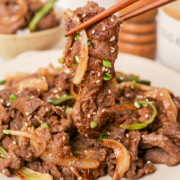

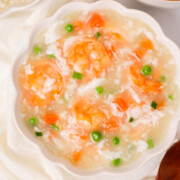
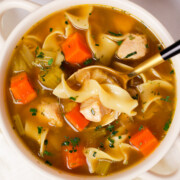
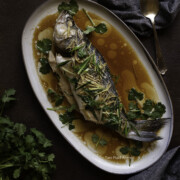


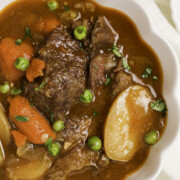
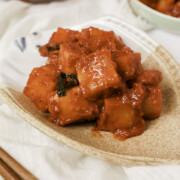
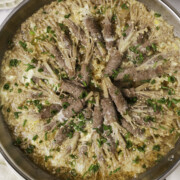
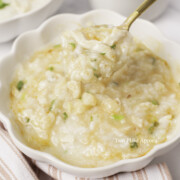





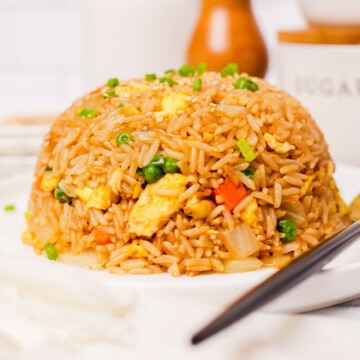
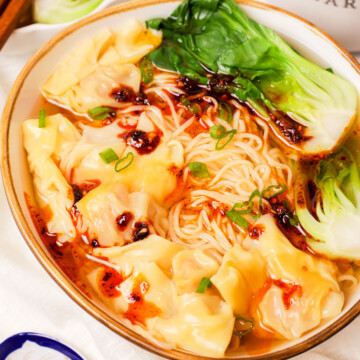
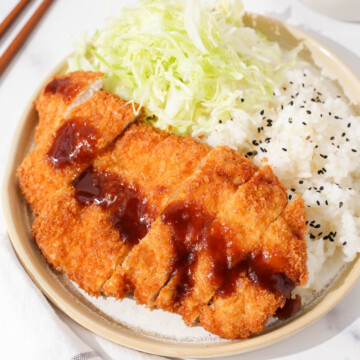
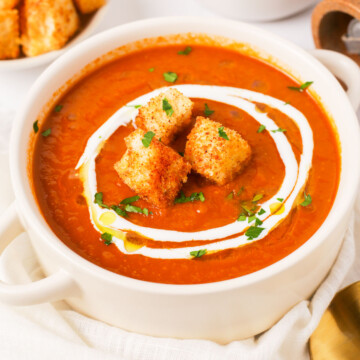
Comments
No Comments